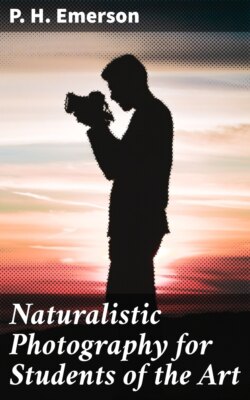Читать книгу Naturalistic Photography for Students of the Art - P. H. Emerson - Страница 11
На сайте Литреса книга снята с продажи.
CHAPTER II.
NATURALISM IN PICTORIAL AND GLYPTIC ART.
ОглавлениеTable of Contents
An inquiry into the influence of the study of nature on art.
In this chapter we shall endeavour to trace the influence of the study of nature on all the best art up to the present day. |Woltmann and
Woermann.| In order to do this it will be necessary to follow in chronological order the development of art, and we propose taking as our guide in this matter Messrs. Woltmann and Woermann, who seem the most trustworthy and are the most recent of art historians. We feel, however, that we must state our attitude towards them as historians of art. For the main historical facts, we willingly accept as authorities these writers, since they have studied the matter, but when these historians try to trace the causes and effects of different phases of art on contemporary life then we entirely part company from them, for there are so many wheels within wheels in this complex comedy of life that we cannot with patience listen to searchers of manuscripts and students of autographs, who trace the fall of an empire to an oil painting, or the decadence of painting to the cheapness of wheat: such dreams may still serve, as they have always served, as a peg whereon to hang rhetorical rhapsodies, but they can have no attraction for rational minds. What we propose, then, is briefly to compile a short outline, consisting of the salient facts in the history of art, in so far as they bear on our subject, that is, how far the best artists have been naturalistic, and how true in impression their interpretation of nature. When we agree with any of the critical remarks of these gentlemen, we shall quote them in full, acknowledging them in the usual way, but we reserve to ourselves the right to differ entirely from them on artistic points. We ourselves feel much diffidence in advancing any critical remarks of our own upon these arts, for we are convinced, after a long and practical study of the subject, that no one can criticize any branch of art and the criticism be authoritative, unless he be a practical master artist in the branch of art which he is criticizing; but as our opinions have been put to the touchstone of some first-rate practical artists in other branches than our own, we offer them, standing always ready to be corrected by any good practical artist on any point. As to who are good artists is again another wide question. Certainly their name is not legion.
Criticism.
Our object in traversing all this ground, then, is one of inquiry, to really see how far “naturalism” is the only wear for all good art, and we have done it in an impartial spirit, arriving at the conclusion that in all the glyptic and pictorial arts the touchstone answers. How far this is the case with the arts of Fiction, Poetry, &c., is a more complex matter, and one we cannot now deal with, but we feel that in the literary arts the matter is very different, for in these arts we are not confined, as we are in the pictorial and glyptic arts, to physical facts and their representation; for there is no such thing as abstract beauty of form or colour. Art has served as a peg on which to hang all sorts of fads—fine writing, very admirable in its place—morality, not to be despised—classical knowledge and literature generally, both of the highest æsthetic value, but in no way connected with the glyptic and pictorial arts. Naturalistic art has been found and lost, and lost and found time after time, and it is because the Dutch, French, English and American artists of to-day are finding it again that we feel hopeful for the art of the future.
Our aim.
Our object is, by these notes, to lead our readers to the works of art themselves, hoping that by this means they will, to some extent, educate themselves and finally form independent judgments on art matters. Much of the lamentable ignorance existing on these subjects is due to the acceptance of the dicta of writers on pictures, without the readers seeing the pictures themselves. We earnestly beg, therefore, of any one who may be sufficiently interested in the subject as to read this book, that he will go and see the original pictures and sculptures cited; all of which are within easy reach. It was our original intention to introduce photographic reproductions of the best pieces of sculpture, and the best pictures into this work, but we have decided against so doing, fearing that the reader might be tempted to look at the reproductions and neglect the originals, and a translation, however good it may be, is but a small part of the truth. In thus expressing our conclusions on naturalism in art, we do not set up as the preacher of any new gospel. Such opinions as ours are as old as the art of ancient Greece, nay older, for from the early days of Egypt downwards these ideas have been held, we shall find, by great artists in all ages. It is only in the application of these ideas to photography, and in attempting to reduce them to scientific first principles that we presume to claim any originality.
